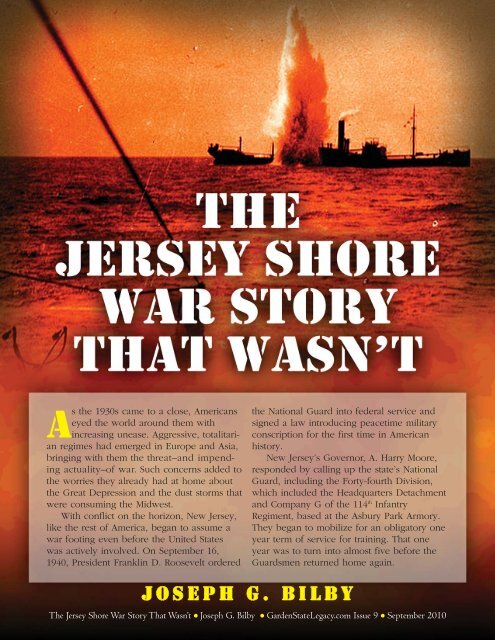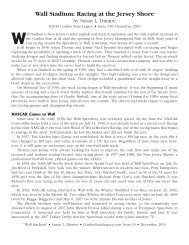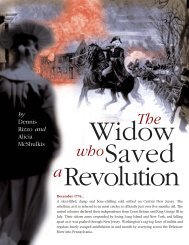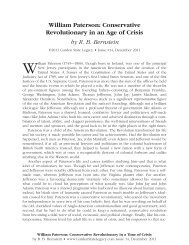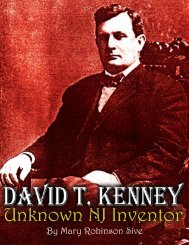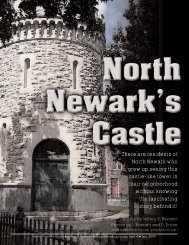The Jersey Shore War Story That Wasn't - Garden State Legacy
The Jersey Shore War Story That Wasn't - Garden State Legacy
The Jersey Shore War Story That Wasn't - Garden State Legacy
You also want an ePaper? Increase the reach of your titles
YUMPU automatically turns print PDFs into web optimized ePapers that Google loves.
As the 1930s came to a close, Americans<br />
eyed the world around them with<br />
increasing unease. Aggressive, totalitarian<br />
regimes had emerged in Europe and Asia,<br />
bringing with them the threat—and impending<br />
actuality—of war. Such concerns added to<br />
the worries they already had at home about<br />
the Great Depression and the dust storms that<br />
were consuming the Midwest.<br />
With conflict on the horizon, New <strong>Jersey</strong>,<br />
like the rest of America, began to assume a<br />
war footing even before the United <strong>State</strong>s<br />
was actively involved. On September 16,<br />
1940, President Franklin D. Roosevelt ordered<br />
the National Guard into federal service and<br />
signed a law introducing peacetime military<br />
conscription for the first time in American<br />
history.<br />
New <strong>Jersey</strong>’s Governor, A. Harry Moore,<br />
responded by calling up the state’s National<br />
Guard, including the Forty-fourth Division,<br />
which included the Headquarters Detachment<br />
and Company G of the 114 th Infantry<br />
Regiment, based at the Asbury Park Armory.<br />
<strong>The</strong>y began to mobilize for an obligatory one<br />
year term of service for training. <strong>That</strong> one<br />
year was to turn into almost five before the<br />
Guardsmen returned home again.<br />
J o s e p h G . B i l b y<br />
<strong>The</strong> <strong>Jersey</strong> <strong>Shore</strong> <strong>War</strong> <strong>Story</strong> <strong>That</strong> Wasn’t Joseph G. Bilby <strong>Garden</strong><strong>State</strong><strong>Legacy</strong>.com Issue 9 September 2010
(Above) Asbury Park <strong>State</strong> Guards on duty at the Route 9 Bridge over the<br />
Raritan River in December 1941.<br />
(Left) Governor Charles Edison New <strong>Jersey</strong> <strong>State</strong> Archives<br />
To take their place, New <strong>Jersey</strong> raised a “<strong>State</strong> Guard” militia, based at<br />
existing National Guard Armories—many of them built a few years<br />
before with federal money as WPA projects. Asbury Park’s armory<br />
became headquarters for Company B of the Guard’s Eighth Battalion.<br />
In December 1941, within a week of the Pearl Harbor attack,<br />
Company B left the city to assume temporary guard duty on the<br />
Route 9 Victory Bridge across the Raritan River. 1<br />
By the spring of 1942, as its draftees and volunteers followed the<br />
Guardsmen into service, the war came home dramatically to the New<br />
<strong>Jersey</strong> <strong>Shore</strong>. In June, a seven mile stretch of beach south of Asbury<br />
Park, from Belmar to Manasquan, was covered with “oil and tar<br />
residue” and debris from sunken ships. <strong>The</strong> Nazis had launched<br />
Operation Drumbeat, an all-out attack on American shipping. German<br />
submarines came so close to the coast that the crewmen listened to<br />
local radio stations. 2<br />
In response to this threat, the army’s Second Corps military command,<br />
which included New <strong>Jersey</strong>, advised the state then-Governor,<br />
Charles Edison, that it “desired all lights along the New <strong>Jersey</strong> seacoast<br />
be dimmed or eliminated as the present lights silhouetted a ship<br />
<strong>The</strong> <strong>Jersey</strong> <strong>Shore</strong> <strong>War</strong> <strong>Story</strong> <strong>That</strong> Wasn’t Joseph G. Bilby <strong>Garden</strong><strong>State</strong><strong>Legacy</strong>.com Issue 9 September 2010
(Above) Soldiers from the 113th Infantry, NJ National Guard, drilling in<br />
Newark's Branch Brook Park in September 1940, after being called to<br />
active duty. NGMMNJ<br />
(Right) Samuel Eliot Morrison.<br />
at sea making it an easy target for submarines lurking beyond the sea<br />
lanes where ships travel.”<br />
Leonard Dreyfuss, director of the state’s Defense Council, said he<br />
would contact the municipal officials of the shore towns, who had<br />
already expressed a desire to cooperate. Although local citizens in<br />
Cape May were annoyed that the Cape May Naval Base was not<br />
subjected to the same dim-out regulations that they were, by<br />
March 24 the navy expressed itself as “quite satisfied” with the<br />
dim-out between the Atlantic Highlands and Sea Girt. 3<br />
A bit of conventional wisdom accepted by many historians<br />
that disparages the <strong>Jersey</strong> shore is that in the spring of 1942<br />
merchants in Atlantic coastal communities deliberately violatedgovernment<br />
dim-out in order to continue to attract<br />
tourists—an act which led to the sinking of American<br />
ships. One has even asserted that “ships and lives were<br />
held hostage to tourist dollars.”<br />
This view apparently has its origins in the work<br />
of highly respected Harvard scholar Samuel Eliot<br />
Morison, who wrote the navy’s official history of<br />
<strong>The</strong> <strong>Jersey</strong> <strong>Shore</strong> <strong>War</strong> <strong>Story</strong> <strong>That</strong> Wasn’t Joseph G. Bilby <strong>Garden</strong><strong>State</strong><strong>Legacy</strong>.com Issue 9 September 2010
Asbury Park Armory (1908)<br />
the war, and called this alleged defiance “most<br />
reprehensible.” <strong>The</strong> problem with Morison’s<br />
account is that, at least in the case of New<br />
<strong>Jersey</strong>, it was completely untrue, as a reading<br />
of the state’s Governor’s <strong>War</strong> Cabinet Minutes<br />
readily reveals. 4<br />
On April 9th Director Dreyfuss reported to<br />
Governor Edison that he had personally visited<br />
Asbury Park at night and that “the town was in<br />
almost total darkness.” Far from being concerned<br />
that merchants were defying the regulations,<br />
Dreyfuss felt that “it was not necessary<br />
that the dim out be so complete.” Two weeks<br />
later the navy reported that although some<br />
Cape May lights could be seen thirty miles at<br />
sea, they were “not objectionable,” and that<br />
“generally all of the [coastal] dim out was<br />
acceptable. By May, state officials thought the<br />
dim-out along the whole coast “most effective,”<br />
although some Atlantic City lights were still too<br />
visible. An assessment two weeks later, however,<br />
showed the deficiencies had been fixed and<br />
pronounced New <strong>Jersey</strong>’s efforts as “about as<br />
perfect as could be expected.” 5<br />
In late May federal regulations on coastal<br />
lighting were tightened to include traffic lights<br />
and all exterior advertising, as well as automobile<br />
headlights. Drivers in coastal towns were<br />
only allowed to use their parking lights, which<br />
caused an increase in automobile accidents<br />
almost immediately. An end of the year assessment<br />
concluded that dim-out programs<br />
increased vehicular accident rates by one hundred<br />
percent. Although some navy officers<br />
were not completely satisfied that the new regulations<br />
were being effectively enforced, a<br />
team of state officials and an army general<br />
conducted a thorough inspection from the sea<br />
on June 1 and concluded that “New <strong>Jersey</strong> was<br />
effectively dimmed out” with the ironic exception<br />
of the Navy installation at Cape May.<br />
Photos taken from the ocean afterwards<br />
<strong>The</strong> <strong>Jersey</strong> <strong>Shore</strong> <strong>War</strong> <strong>Story</strong> <strong>That</strong> Wasn’t Joseph G. Bilby <strong>Garden</strong><strong>State</strong><strong>Legacy</strong>.com Issue 9 September 2010
evealed that “navigation lights from the naval<br />
station definitely made a glare or glow, whereas<br />
normal lighting in cities such as Asbury Park<br />
and Long Branch showed up black in the photographs.”<br />
6<br />
Navy complaints continued, however, and at<br />
the end of July the Governor’s <strong>War</strong> Cabinet<br />
received a letter and a series of time lapse photos<br />
allegedly revealing incomplete dim-out compliance<br />
in some shore communities, including<br />
automobile headlights in Mantoloking pointing<br />
seaward. Dreyfuss thought the evidence invalid,<br />
but Edison agreed to look into it. A subsequent<br />
state police investigation revealed that the photographs<br />
were overexposed and that dim-out<br />
regulations were reasonably well obeyed and<br />
enforced and that the dim-out in Asbury Park in<br />
particular was “quite effective.”<br />
<strong>The</strong>re is absolutely no evidence to sustain<br />
Morison’s allegations that New <strong>Jersey</strong> shore<br />
merchants deliberately disobeyed dim-out regulations<br />
to bolster their tourist trade during the<br />
deadly summer of 1942.<br />
It’s time to refute this war story that wasn’t<br />
and restore the good name of the people along<br />
the <strong>Jersey</strong> <strong>Shore</strong>. 7<br />
1. John K. Mahon, History of the Militia and National Guard (New York: Macmillan, 1983) pp.<br />
179–180; Asbury Park Evening Press, December 16, 1941.<br />
2. Robert Kurson, Shadow Divers (New York, Random house, 2004), p. 235.<br />
3. Governor’s <strong>War</strong> Cabinet Minutes, March 2, 24, 1942, NJ <strong>State</strong> Archives,<br />
http://www.njarchives.org/links/guides/szwaa001.html<br />
4. Mark Edward Lender, One <strong>State</strong> in Arms: A Short Military History of New <strong>Jersey</strong> (Trenton: NJ<br />
Historical Commission, 1991), pp 88–89.<br />
5. Governor’s <strong>War</strong> Cabinet Minutes, April 9, 24, May 4, 19, 1942.<br />
6. Ibid, June 9, 16, November 10, 1942.<br />
7. Ibid, July 28, August 11, 1942; Asbury Park Press, September 22, 2002.<br />
<strong>The</strong> <strong>Jersey</strong> <strong>Shore</strong> <strong>War</strong> <strong>Story</strong> <strong>That</strong> Wasn’t Joseph G. Bilby <strong>Garden</strong><strong>State</strong><strong>Legacy</strong>.com Issue 9 September 2010


